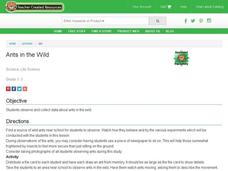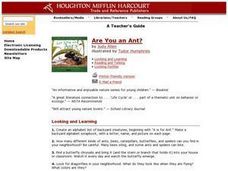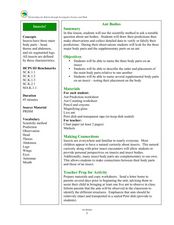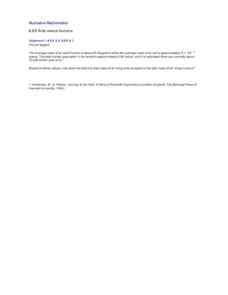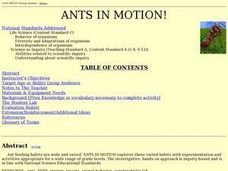Curated OER
Ants
Ants are a common example to use when conducting lessons on insects, and if your youngsters are squeamish, this is a way to introduce them without actually bringing them into the classroom! Viewers of this PowerPoint learn about the...
Curated OER
The Amazing Ant
Students explain that ants are an important element of nature's balance. Ants eat many insects and are food to other animals. They watch a video and conduct hands-on activities that give them an excellent overview of the ants role in...
Curated OER
When Ants Fly
Here is a great lesson on constructing line graphs. Learners identify common characteristics of birds, ants common needs of all living things. They also write a story from the perspective of an ant or a bird that has lost its home and...
Ask a Biologist
The Many Faces of Ants
Though they be but little, they are fierce! Young biologists read about eight different species of ants, and discover how the anatomy of their heads can explain the way they live and what they eat.
Curated OER
Introduce Vocabulary: "I Can't," Said the Ant (Cameron)
With both rhyme and a fun storyline, Polly Cameron's story "I Can't," Said the Ant is a useful resource for vocabulary in context. Emerging readers focus on five key words: cooperate, mend, nimble, sling, and trickle. After a brief...
Houghton Mifflin Harcourt
Zombie Ants
One of the creepiest and coolest natural occurrences is a great forum for data analysis and discussion! Explore the phenomenon of zombie ants, or ants infected with the Cordyceps fungus, with a series of activities and experiments. Kids...
PhysEdGames
Dead Ant Tag
Tag, you're a dead ant! Players run around the playing area and runs from the taggers. If a player gets tagged, then they must lay on the ground with their arms and legs in the air. To get back into the game, four people must touch the...
Curated OER
The Ants Go Marching
Integrate art, math, life science, music, and fun in this beginning addition and subtraction activity. Children kinesthetically represent adding and subtracting numbers to 10; they stand up one at a time as you count forward and sit down...
Curated OER
Adam Ant Lyrics
High school learners can hone their research skills by employing the Internet to find the answers to trivia questions. This resource focuses on questions about the musician, Adam Ant. There are 10 questions posed.
Curated OER
Ant Arcitecture
Students create pages of a classroom book on the different structures that ants build. They view and discuss a video on ants then, in small groups, research a type of ant shelter. They relate the shelter to the environment in which the...
Curated OER
Ants
Third graders study the habits and habitats of ants. They research the use of technology as a valuable investigation tool and access other web sites for future research projects. The students make successful decisions while playing SimAnt.
ReadWriteThink
Teaching Point of View With Two Bad Ants
What better way to explain the concept of point of view than from an ant's perspective! After reading Two Bad Ants, pupils identify the point of view of the ants by studying the text and pictures. Then, they fill out a chart that...
Curated OER
Ants in the Wild
Students investigate ants in the wild. In this insect lesson plan, students observe ant colonies and conduct experiments, such as putting food in the ants' path. Students record their observations.
Curated OER
Take an Ant to Lunch
Second graders construct a model of an ant, exemplifying that ants are insects. Students gather data create a pictograph chart to show ant food preferences. Also, 2nd graders access the Internet to explore ant eating habits.
Curated OER
Ants
Students make sequential patterns by using ants and following the model. They identify different parts of an ant by matching the picture to the word name. Pupils identify the ant's life cycle by creating a chart using pictures.
Curated OER
The Behavior of Ants
Young scholars use the steps of the Scientific Method to develop and test their own ideas through experimentation with ants.
Curated OER
Are You an Ant?
Students investigate different insects in their backyard. In this insect lesson, students read the book Are You and Ant? and apply the reading to their backyards. Students create a list of animals that begin with the the letter A an make...
Curated OER
100 Hungry Ants
After hearing the story, One Hundred Angry Ants, learners apply what they have seen to a math challenge. They choose one of three numbers: 12, 24, or 36. Imagining this were the number of ants going to a picnic, they consider how many...
Curated OER
Did You Know?
Learn about ants and printing in one fun worksheet! After you read some interesting facts about ants, practice writing the word ant on a tracing line. Then, draw a picture of an ant in a space provided.
Curated OER
Ant and Elephant
Have you ever wondered how many ants make up an elephant? Inquisitive minds will be amazed as they use scientific notation to compute and compare the mass of an elephant to an ant. Have participants make guesses and see how close they...
Curated OER
Ant Bodies
Learners name the three parts that comprise an insect body. In this ant lesson, students make connections regarding the curiosity of insects as it touches upon the learners' personal perspectives. Students then observe ants in class and...
Illustrative Mathematics
Ants Versus Humans
You would think that humans make up more mass than ants do on this planet, but think again, and this time by performing calculations. Middle schoolers use scientific notation to compute and compare the estimated total mass of all humans...
CPALMS
Point of View: A Close Reading of Two Bad Ants
Chris Van Allsburg's Two Bad Ants provides third graders with an opportunity to examine point of view and how the point of view of others may differ from their own.
Curated OER
Ants In Motion
Students brainstorm ants and their characteristics in a class discussion. They observe the ants and answer question pertaining to their behavior; then they apply the scientific method in creating and investigating a problem.
Other popular searches
- Two Bad Ants
- 100 Hungry Ants
- One Hundred Hungry Ants
- Ants Body Parts
- Ants Point of View
- Art and Ants
- One Hundred Angry Ants
- 100 Angry Ants
- Environmental Toxic Ants
- Mice Men Ants
- Ants Lesson Plan
- Fire Ants














